Tree Breadth First Search Strategies Flashcards
Binary Tree Level Order Traversal

Given a binary tree, populate an array to represent its level-by-level traversal. You should populate the values of all nodes of each level from left to right in separate sub-arrays.
Since we need to traverse all nodes of each level before moving onto the next level, we can use the Breadth First Search (BFS) technique to solve this problem.
We can use a Queue to efficiently traverse in BFS fashion. Here are the steps of our algorithm:
- Start by pushing the
rootnode to the queue. - Keep iterating until the queue is empty.
- In each iteration, first count the elements in the queue (let’s call it
levelSize). We will have these many nodes in the current level. - Next, remove
levelSizenodes from the queue and push theirvaluein an array to represent the current level. - After removing each node from the queue, insert both of its children into the queue.
- If the queue is not empty, repeat from step 3 for the next level.
The time complexity of the above algorithm is O(N), where ‘N’ is the total number of nodes in the tree. This is due to the fact that we traverse each node once. The space complexity of the above algorithm will be O(N) as we need to return a list containing the level order traversal. We will also need O(N) space for the queue. Since we can have a maximum of N/2 nodes at any level (this could happen only at the lowest level), therefore we will need O(N) space to store them in the queue.
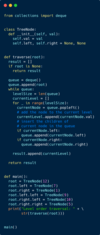
Reverse Level Order Traversal

Given a binary tree, populate an array to represent its level-by-level traversal in reverse order, i.e., the lowest level comes first. You should populate the values of all nodes in each level from left to right in separate sub-arrays.
This problem follows the Binary Tree Level Order Traversal pattern. We can follow the same BFS approach. The only difference will be that instead of appending the current level at the end, we will append the current level at the beginning of the result list.
Here is what our algorithm will look like: As in the case of ArrayList, appending an element at the beginning means shifting all the existing elements. Since we need to append the level array at the beginning of the result list, a LinkedList will be better, as this shifting of elements is not required in a LinkedList. Similarly, we will use a double-ended queue (deque) for Python.
The time complexity of the above algorithm is O(N), where ‘N’ is the total number of nodes in the tree. This is due to the fact that we traverse each node once.
The space complexity of the above algorithm will be O(N) as we need to return a list containing the level order traversal. We will also need O(N) space for the queue. Since we can have a maximum of N/2 nodes at any level (this could happen only at the lowest level), therefore we will need O(N) space to store them in the queue.

Zigzag Traversal

Given a binary tree, populate an array to represent its zigzag level order traversal. You should populate the values of all nodes of the first level from left to right, then right to left for the next level and keep alternating in the same manner for the following levels.
This problem follows the Binary Tree Level Order Traversal pattern. We can follow the same BFS approach. The only additional step we have to keep in mind is to alternate the level order traversal, which means that for every other level, we will traverse similar to Reverse Level Order Traversal.
The time complexity of the above algorithm is O(N), where ‘N’ is the total number of nodes in the tree. This is due to the fact that we traverse each node once.
The space complexity of the above algorithm will be O(N) as we need to return a list containing the level order traversal. We will also need O(N) space for the queue. Since we can have a maximum of N/2 nodes at any level (this could happen only at the lowest level), therefore we will need O(N) space to store them in the queue.

Level Averages in a Binary Tree

Given a binary tree, populate an array to represent the averages of all of its levels.
This problem follows the Binary Tree Level Order Traversal pattern. We can follow the same BFS approach. The only difference will be that instead of keeping track of all nodes of a level, we will only track the running sum of the values of all nodes in each level. In the end, we will append the average of the current level to the result array.
The time complexity of the above algorithm is O(N), where ‘N’ is the total number of nodes in the tree. This is due to the fact that we traverse each node once.
The space complexity of the above algorithm will be O(N) which is required for the queue. Since we can have a maximum of N/2 nodes at any level (this could happen only at the lowest level), therefore we will need O(N) space to store them in the queue.

Minimum Depth of a Binary Tree

Find the minimum depth of a binary tree. The minimum depth is the number of nodes along the shortest path from the root node to the nearest leaf node.
This problem follows the Binary Tree Level Order Traversal pattern. We can follow the same BFS approach. The only difference will be, instead of keeping track of all the nodes in a level, we will only track the depth of the tree. As soon as we find our first leaf node, that level will represent the minimum depth of the tree.
The time complexity of the above algorithm is O(N), where ‘N’ is the total number of nodes in the tree. This is due to the fact that we traverse each node once.
The space complexity of the above algorithm will be O(N) which is required for the queue. Since we can have a maximum of N/2 nodes at any level (this could happen only at the lowest level), therefore we will need O(N) space to store them in the queue.
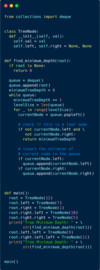
Level Order Successor

Given a binary tree and a node, find the level order successor of the given node in the tree. The level order successor is the node that appears right after the given node in the level order traversal.
This problem follows the Binary Tree Level Order Traversal pattern. We can follow the same BFS approach. The only difference will be that we will not keep track of all the levels. Instead we will keep inserting child nodes to the queue. As soon as we find the given node, we will return the next node from the queue as the level order successor.
The time complexity of the above algorithm is O(N), where ‘N’ is the total number of nodes in the tree. This is due to the fact that we traverse each node once.
The space complexity of the above algorithm will be O(N) which is required for the queue. Since we can have a maximum of N/2 nodes at any level (this could happen only at the lowest level), therefore we will need O(N) space to store them in the queue.
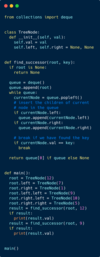
Connect Level Order Siblings

Given a binary tree, connect each node with its level order successor. The last node of each level should point to a null node.
This problem follows the Binary Tree Level Order Traversal pattern. We can follow the same BFS approach. The only difference is that while traversing a level we will remember the previous node to connect it with the current node.
The time complexity of the above algorithm is O(N), where ‘N’ is the total number of nodes in the tree. This is due to the fact that we traverse each node once.
The space complexity of the above algorithm will be O(N), which is required for the queue. Since we can have a maximum of N/2 nodes at any level (this could happen only at the lowest level), therefore we will need O(N) space to store them in the queue.
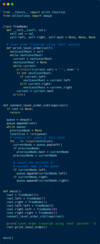
Connect All Level Order Siblings

Given a binary tree, connect each node with its level order successor. The last node of each level should point to the first node of the next level.
This problem follows the Binary Tree Level Order Traversal pattern. We can follow the same BFS approach. The only difference will be that while traversing we will remember (irrespective of the level) the previous node to connect it with the current node.
The time complexity of the above algorithm is O(N), where ‘N’ is the total number of nodes in the tree. This is due to the fact that we traverse each node once.
The space complexity of the above algorithm will be O(N) which is required for the queue. Since we can have a maximum of N/2 nodes at any level (this could happen only at the lowest level), therefore we will need O(N) space to store them in the queue.

Right View of a Binary Tree

Given a binary tree, return an array containing nodes in its right view. The right view of a binary tree is the set of nodes visible when the tree is seen from the right side.
This problem follows the Binary Tree Level Order Traversal pattern. We can follow the same BFS approach. The only additional thing we will be do is to append the last node of each level to the result array.
The time complexity of the above algorithm is O(N), where ‘N’ is the total number of nodes in the tree. This is due to the fact that we traverse each node once.
The space complexity of the above algorithm will be O(N) as we need to return a list containing the level order traversal. We will also need O(N) space for the queue. Since we can have a maximum of N/2 nodes at any level (this could happen only at the lowest level), therefore we will need O(N) space to store them in the queue.
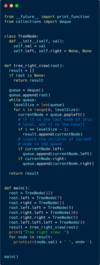
Tree Boundary

Given a binary tree, return an array containing all the boundary nodes of the tree in an anti-clockwise direction.
The boundary of a tree contains all nodes in the left view, all leaves, and all nodes in the right view. Please note that there should not be any duplicate nodes. For example, the root is only included in the left view; similarly, if a level has only one node we should include it in the left view.
This problem follows the Binary Tree Level Order Traversal pattern and shares algorithmic logic with Right View of a Binary Tree. We can follow the same BFS approach. While traversing different levels, we will populate three arrays:
- Tree Left View - contains the first node of each level
- Leaves - contains all leaf nodes.
- Tree Right View - contains the last node of each level
Finally, we will merge these three arrays to calculate the tree boundary.
To find the leaves in the left to right order we can’t use BFS because any leaf node coming in a higher level will not necessarily come before a leaf on the lower level. To understand this, take a look at Example-2 above. In this example, node ‘10’ should always come after node ‘15’. To handle this scenario we will be using Depth First Search (DFS).



